GROOMING AND
SHOWING THE IRISH WOLFHOUND
ROBERT HUNTER
Reprinted with kind
permission of the author
|
For
GROOMING
specific details
of showing within Australia, refer to the
article "Showing
the Wolfhound within Australia".
Dog show judgements are an aesthetic experience bases upon certain observable appearances which indicate soundness of body, condition, and breed type. The appearances judged are at all times relative: relative to the judge’s personal experiences, relative to other dogs in the breed and relative to the "standard. Saying this is to assure the reader that whatever is presented in this article as truth and/or authority is relative to the author’s opinion, tempered by written sources and personal observations. The description of grooming and showing practices outlined will follow the "List of Points in Order of Merit" found in the A.K.C. Irish Wolfhound Standard. 1. Typical. The Irish Wolfhound is a rough-coated Greyhound-like breed, the tallest of the coursing hounds and remarkable in combing power and swiftness. The historical references used to describe the IW are often interchangeable with six other breeds; the Greyhound, Afghan, Saluki, Scottish Deerhound, Borzoi and more recently the Whippet. These breeds are referred to as "sighthounds" and differ from other breeds because of their racing conformation. |
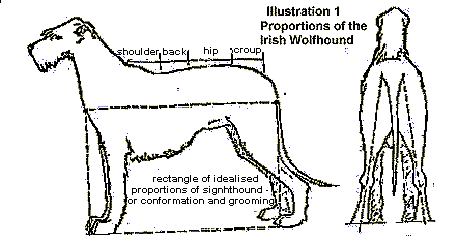
|
Because they are racing dogs, the most typical
conformation impression should be formed by the
depth of chest, tucked up belly, slight arching
over the loins, long rear legs with muscular
thighs, well bent or angulated stifles and well
let down hocks.
Further, an impression of "off Balance" of the forequarters should be observed. All racing dogs’ forelegs are ahead of the center of gravity of the dog, thus presenting the "off balance" appearance when viewed in profile. By comparison, in the working breeds the chest protrudes in front of the forelegs thus positioning the forelegs directly under the center of gravity. The neck and back should be long and slightly arched. (The bitch has a more level back than a dog.) The long back serves the functional demands of racing by providing sufficient stretch for the "double suspension" gallop found only in coursing breeds. The appearance of swiftness and power can only be judged subjectively in the show ring. Altogether, the IW should have a general racing appearance although being considerably more massive and powerful than the other sighthounds, and taller too. Grooming and showing the IW should be consistent with demonstrating the typical look of the breed 2. Great Size and commanding appearance. While size is not subjective, the appearance of size is often so. One simple handling technique which gives the appearance of size is holding the IW’s head up by putting the collar up behind the ears (fig 2). Train the IW to stand as in Fig. 3. It is a relaxed and comfortable stance, which will show him at his best. The forelegs should be directly under the shoulder (broken line). The rear feet should be aligned with an imaginary line from the rear of the thighs (broken line). From the rear view, the legs should be set as illustrated, and not wider apart as a Doberman or guard dog is posed. To do the latter actually lowers the height of the IW. A grooming technique which gives the appearance of size is to show more "daylight" under the IW by combing down the chest and underside hair and by gently stripping out the belly and most of the surrounding hair. |
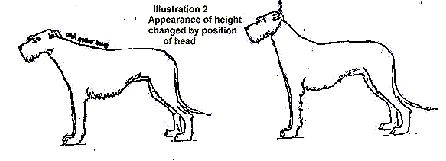
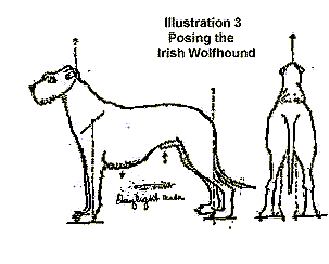
|
3.
Movements easy and active.
To properly show the IW for movement, it is suggested that you read McDowell Lyon’s description of gait in the Complete Irish Wolfhound. A further treatment is found in Mr. Lyon’s book The Dog In Action which is perhaps the best treatment on the subject written to date. Movement is probably the most misunderstood judgement in dog showing. It is for this reason that Lyon’s well illustrated and clearly written expositions are recommended. One empirical suggestion that the reader can use to determine gait is to observe tracks left in snow or wet sand as the dog gaits freely. A properly moving dog will leave a single track, one paw print immediately adjacent to or on top of the preceding print. 4. Head long and level, carried high. The dog and bitch heads show what is often referred to as "dogginess" or "bitchines" in type. Many times a judge will remark " I like a doggy dog and a bitchy bitch", to express a preference for clearly differentiated sex appearance. The head often times gives the clearest indication of this distinction. (Fig. 4) |
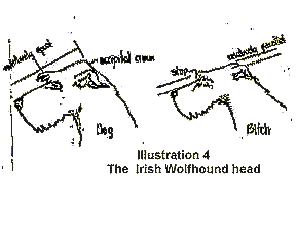
|
The
head should be trimmed, if necessary, to enhance
the silhouette of the long head, the pronounced
occipital crown and the rather squarish muzzle.
It may be necessary to strip the head from just
behind the stop to the rear of the crown,
blending into the base of the neck and shoulders.
Depending on the animal, it may be necessary to
thin out the
bushy hair - especially the soft flyaway
hair over the eyes. This hairy adornment should
give a characteristic IW appearance and not be
cute or look like someone’s forgotten motor cap.
The ears should be stripped of all hair, and the ear base and inner ear should be tided up and look cared for. Just below the jaw and upper neck, it is advisable to severely strip the bushiness and blend the neck hair into the chest and forequarters in a clean unbroken line. This practice will offset the head beautifully and often will give the illusion of length to the neck. Copious chin hair seems most characteristic of the dog; however some bitches have a good deal of facial furnishings. In either case, chin hair gives the IW a characteristic appearance. Prior to showing the IW, the chin hair should be cleaned and combed. Generally, excessive hair about the jaws, below the ears and on the upper neck can easily hide a good head. It is suggested that this hair be removed by stripping and/or by using thinning shears to blend it into the rest of the head (Fig. 5). |
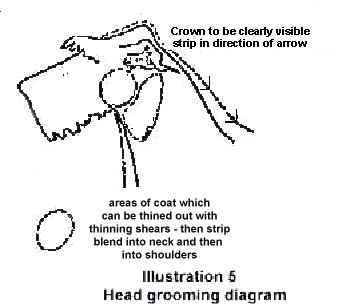
|
5.
Forelegs, heavily boned, quite straight, elbows
well set under.
The forelegs should be straight and parallel to each other. Excessive hair on the forelegs can give the appearance of cobbiness, or worse, coarseness . The tufts of hair at the elbows should conform to the function of the elbow, and not give the impression of a hairy flag. Strip excessive hair away from the elbow so that it has a clean appearance. Attention to the pasterns should consist of tidying by stripping away some of the fuzz so that the pastern bend can be seen (Fig. 6). |
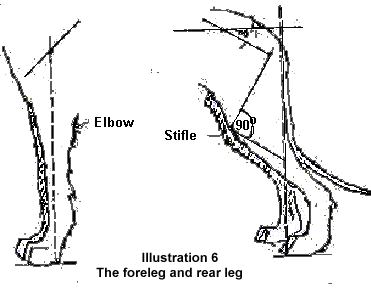
|
6.
Thighs long and muscular; second thighs, well
muscled, stifles nicely bent.
The importance of the thighs and their appearances cannot be overemphasised. The long muscular thigh, being typical of the breed; is one of the more elegant form/function conformation concerns. The thighs are the drive shaft of the racing dog. The preparation of the thighs requires sound decision when preparing to groom. Often excessive undercoat and fluffy hair abound on the stifle edge of the leg. This hair can disguise good angulation or, even worse, create a silhouette not consistent with the standard. Much of this hair can be stripped away, but be careful not to scalp the leg. Equally important is the rear of the leg. Many IW’s have pantaloons that give a rear-end heaviness that is undesirable. Heavy stripping may be required here; however, go about it with caution. Step away from the task and make constant comparison between your results and your mind’s image. Exposing the lower stifle angulation and the crisp lines of the hock can spruce up an average IW and make him a winner. Fig. 7 showing the thighs from the rear gives the reader the judge’s view when he considers the rear quarters. The ungroomed and uncombed thighs shown on the right give the impression that the dog is possibly overweight or not "true". This results from an overgrowth of undercoat and lack of grooming. The general impression is one of "roundness". The illustration on the left is the same dog without an abundance of hair. |
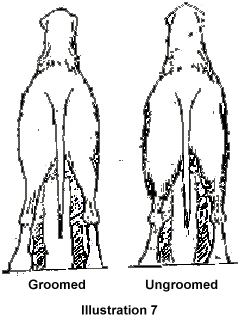
|
7.
Coat, rough and hard, especially wiry and long
over eyes and under jaw.
With some exceptions, there seem to be many IW’s without "wiry" coats. The cause of this problem is hard to diagnose. What comes to mind when studying the IW standard is the description of the Irish Terrier coat. This type of terrier coat is developed and maintained by intensive stripping. This would seem anathema to most IW owners and is not suggested; however, stripping in judicious dabs may be one way to develop a good coat. Excessive baths also make a wiry coat hard to obtain. Hard brushing with coat powder is satisfactory for most cleaning. 8. Body, long and well ribbed up, with ribs well sprung and good breadth across hips. Again, a particularly characteristic impression of the sighthound is the long body. To see a racing dog in the full double suspension gallop - tucked up and full out - is to see the functional necessity for the length of the body. The amount of ground covered in the full out position is a sight to behold. The long body stretch is the aesthetic of function. To show length of body, pose the IW so that his hind foot is in line with an imaginary line dropped vertically to the floor and just touching the rear thigh and the front of the rear foot. (Fig. 1). If the foot is brought forward of that line, it will lower the dog’s rear quarters and make him look smaller in size, confusing the body length with the thigh and thus making the animal look structurally weak. Ribbed out does not mean "barrel chested". On the deep chested dog, the ribs characteristically are directed to the rear of the dog, winding back to the breast bone, or sternum in a somewhat flat three-dimensional curve. Ribbed out refers to the capaciousness of the curve or, in some ways, the total length. 9. Loins arched. Belly well drawn up. Loins arched and belly well drawn up are characteristics of the racing dog. This conformation can easily be seen on the greyhound. Essentially, the IW has the same conformation but is considerably larger in scale and in proportion. The IW’s rough coat can disguise the "tuck-up" and give a long tubular appearance which is not characteristic. For the show dogs stripping or trimming the belly should be given constant and gentle attention. The major stripping at the belly should blend into the thighs and chest and give a smooth line (Fig. 8). |
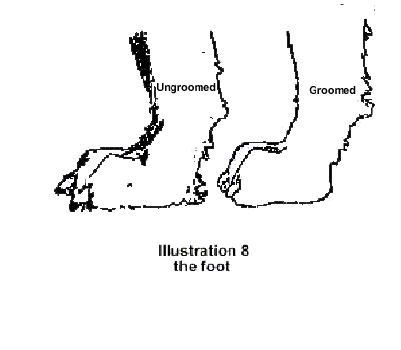
|
10.
Ears, small, with Greyhound-like carriage.
Captain Graham’s Working Stud Book has enough entries about ears to give the reader the notion that they were his major concern. The IW should have a rose ear. Many do not. All the grooming and concern given to this aspect of showing is for the most part wasted. Generally it is recommended that all long hair on the IW’s ear be stripped away and all the bushy hair about the ear be trimmed. This will give the dog a trimmed look and de-emphasize the size of the ear, but it may also amplify a bad ear or ear set. Grooming the ear as well as all grooming must be consistent with the total appearance of the particular dog. It is the exhibitor’s judgement where and where not to venture in grooming. Experience is the best advisor. 11. Feet, moderately large and round; toes, close and well arched. The foot as a functional aspect of the sighthound is an interesting subject, and requires thoughtful concern. Unlike the feet of the scent hound, which should be "thick", compact, and round to aid him in staying with the hunt, the feet of the sighthound should aid him in the specific function of racing. There is conflict between the standard and the functional conformation requirements. The second and third toes (especially of the rear feet) should be longer that the first and fourth toes. The length of the rear feet should provide a leverage gain. There is obviously a limit to the leverage and length, limited by the particular animal and his conformation. However, proportional length is the best functional conformation requirement of the feet. Yet, there is an inherent fault and weakness in the long foot. The foot with well arched toes or "knuckled up" that is esteemed by many because it gives thickness to the foot, resiliency and general staying soundness, can be lost in the long foot. And the further development of the long foot will eventually evolve into a "paper foot" or one which is exceptionally thin and structurally weak. It is therefore a relative choice between the long foot for function, and the not too long foot for soundness. Chapter 11 of Mr. Lyon’s book The Dog In Motion is recommended for it’s treatment of feet. This chapter deals with balanced fronts and makes the choice between knuckled up and the long feet more understandable. For showing the UW, the grooming of the feet is very important. Fig. 9 shows two feet; the one is groomed (trimmed) and the other is not groomed. The silhouette of the ungroomed foot can give the appearance of a paper foot, overly large and ugly. The IW’s nails should be cut back beyond the foot surface. Nails which "clickety clickety" as the dog walks along are too long, and can eventually splay the foot and generally weaken it. Excessive hair about the foot and pasterns should be trimmed. The slight bend in the pasterns should be made observable as it is characteristic of the racing animal. |
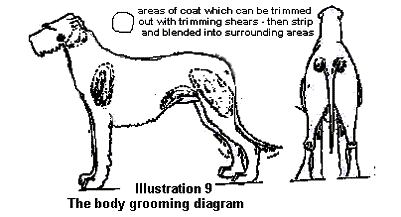
|
12.
Neck, long, well arched and very strong.
There is no doubt that one of the strongest characteristics of the sighthound is the length of neck. In a full suspension gallop, the neck stretches out, allowing the center of gravity to push forward, and thus propels the animal forward. If there is any question about this function of a neck of increased length, closely watch a greyhound race from track side and notice the stretching and throwing of the weight forward so as to achieve speed. The IW should have a proportionally long and well curved or arched neck. The appearance of length can be increased by trimming away the excessive hair about the base of the skull and at the throat immediately adjacent to the lower jaw (not the chin furnishings) and smoothly blending the hair into the heavy coat on the shoulders and chest (see Fig.5 and 6). In other words, reducing the appearance of the size of the head and smoothly blending the coat from the head to the shoulders and chest, will make the neck appear longer and stronger. Again the means of amplifying the neck is a matter of judgement as to what looks best on a particular dog. Perhaps the best way to fully appreciate the unique difference between a long and short neck is to compare working breeds to the coursing hounds. The function of the two groups is different, and one of the most outstanding differences is the conformation of the neck. Elaboration of this difference is a responsibility of the groomer. 13. Chest, very deep, moderately broad. The chest, like the neck, is a characteristic difference between the coursing hound and all other breeds. The conformation of a coursing dog is characterized by a giant chest juxtaposed to the tucked-up loins. Working breeds have the tendency towards breadth of chest while the coursing breeds have the tendency towards depth of chest. The depth of the chest, needed for heart space, should look as though it belongs to the dog and not some enormous addition to his underside The front view should look comfortably wide, but the rib cage should be more slab sided than the barrel shaped. Comparing the Great Dane to an IW of the same size reveals a great deal about the conformation of the chest and the conformation of the IW in general.
The two breeds are distinctly different. In grooming, that difference should be amplified by combing down the hair of the chest and stripping down the rib cage hair so that it lies flat along the cage. As noted above, stripping away some of the fluffy hair from the loins can add to the appearance of the chest size. 14. Shoulders, muscular, set sloping. Ideally in the Irish Wolfhound and the other coursing hounds, the shoulder blade should be set at a 45 degree angle. The only way to determine the angle of a dog’s shoulders is to feel for it. Without proper angulation, the dog would exhibit a very strange gait either from the head -on position or the side position. Grooming can neither hide nor minimize a bad set of shoulders. However, the exhibitor should see to it that the hair on the shoulders is stripped sufficiently so that the hair lies flat against the shoulder blade and is not teased out so that it presents a ballooned or barrel effect. 15. Tail, long and slightly curved. Clearly and simply, the tail should be long and straight. Of course, there can be some variation, but a short tail or a ring tail is considered objectionable. Some grooming of the tail should be done because of the excessive hair on some dogs at the base of the tail. This grooming should blend the base of the tail smoothly into the tail proper. In other words, the appearance of the tail should be relative same thickness throughout the entire tail, with only a slight tapering. 16. Eyes, dark. This is clearly stated. The preference is for dark eyes. A personal observation is that darker coated dogs with light eyes look strange, as their eyes stand out in great contrast while a light coated dog seems to be able to carry light eyes a little better. In conclusion, it is necessary to remind the exhibitor that dog showing is just that, a show. Your preparation for the ring should show the particular dog and the breed to the best advantage. After all, your dog is something special. Last of all, relax and enjoy the show; it can be fun. After all the show is for people; the dogs would probably rather stay home.
|